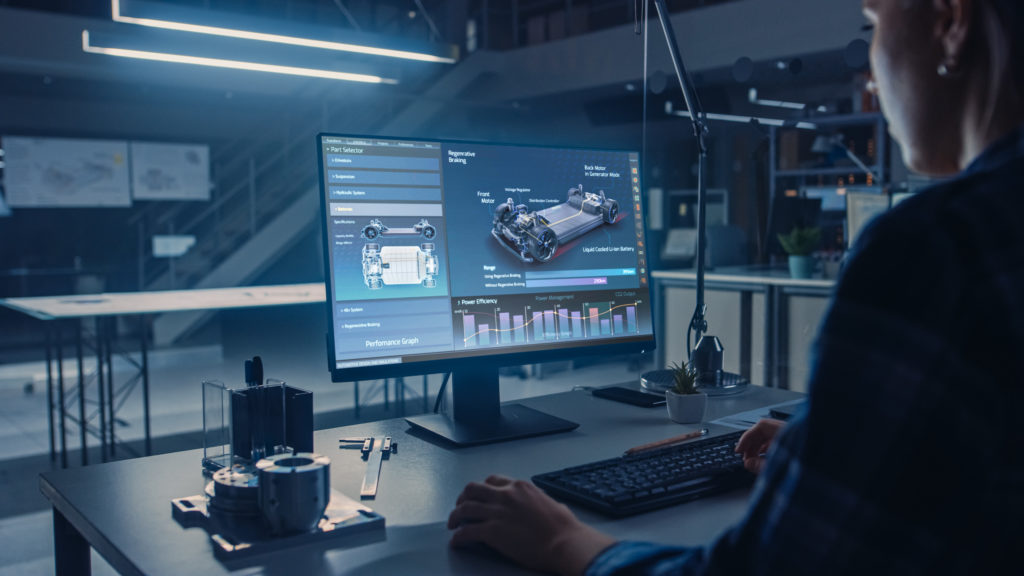These technologies create an immersive simulation for the eye, made with computer graphics. It’s gaming IRL! Glasses or eye pieces can provide augmented reality (AR) which adds (augments) and integrates digital elements to what you already view in the real world. Virtual reality (VR) is typically viewed through goggles that hide the real world, and replace it with an artificial, completely digitally rendered world. AR and VR aren’t just for video games—in manufacturing, elaborate simulations can be created. Users can often interact with trial runs of machines or processes that are cheaper and more efficient than building the real thing. This brings down costs, saves on materials, and is much safer. And, what a great way to learn on the job! This technology creates great roles for individuals who enjoy computers, design, or have instinctive empathy and a user-experience mindset.
Virtual Reality & Augmented Reality
Did you know?
Mechanical engineering is responsible for designing a safety harness for rides in amusement parks.
Outcomes & Solutions

Environmentally Responsible
In manufacturing, you don’t need to build a model or prototype in real life, to know if it works—you can simulate it and find out. Quicker and more efficient production means less energy and waste happen in the manufacturing process. And that reduces greenhouse gas and is better for the environment.

Transform Learning
If the pandemic’s taught us anything, it’s how teachers need support and resources to bring lessons to life—both in the classroom and at home. AR/VR can enable students to learn in an immersive and experiential way to get hands-on experience i.e. learn a trade, explore the human brain, or simulate what happens inside a complex engine. AR/VR allows people to test and learn in real-time virtually, making problem solving quicker and on-the-job training easier.

Safety Training
AR/VR technologies can go a long way to help plant managers and workers ensure production processes and assembly lines operate safely all over the world. For example, this important technology can provide workers with real-time instructions and experience in a safe virtual environment so crucial safety information can be disseminated in a more memorable way. Utilizing VR, Ford auto plants have reduced employee injuries by a remarkable 70%.

Unleash Experimentation
VR makes it possible for architects, designers and engineers to innovate and try new things with their designs. It makes it possible to not only see what's being built, but how it would be to experience it in real life. And, it allows customers to try out new things before they buy them.
Careers Using this Technology
Design Engineer
Design Engineers use AR/VR processes to develop, test, and improve manufacturing processes and product designs, maximizing customer satisfaction and at the same time optimizing productivity. Working on these virtual designs helps optimize a company’s products, as well as how they are made much more efficiently than is possible by tinkering with a real product. Engineers can quickly redesign and perfect in the digital world, without experiencing the ergonomic stresses that arise from hands on assembly processes.

Animator
An animator is a combination of an artist and a storyteller. They create an extensive series of images, form the animation in movies, commercials, television programs, and video games. In advanced manufacturing, animators are the brains that design AR/VR simulations themselves and recommend the best approaches to integrate 3D components into final commercial-quality products. Animators often use AR/VR tools, enabling them to animate keyframes in 3D.

Graphic Designer
A graphic designer is a communicator who creates visual concepts using computer software. They communicate ideas to inspire, inform, or captivate audiences through both physical and virtual art forms. As a graphic designer, you may use tools like VR to create, test, and improve an upfront design before a product is physically produced. For example, in the automotive industry, AR/VR makes it possible to create, personalize, and perfect a car before a single wheel hits the assembly line.


